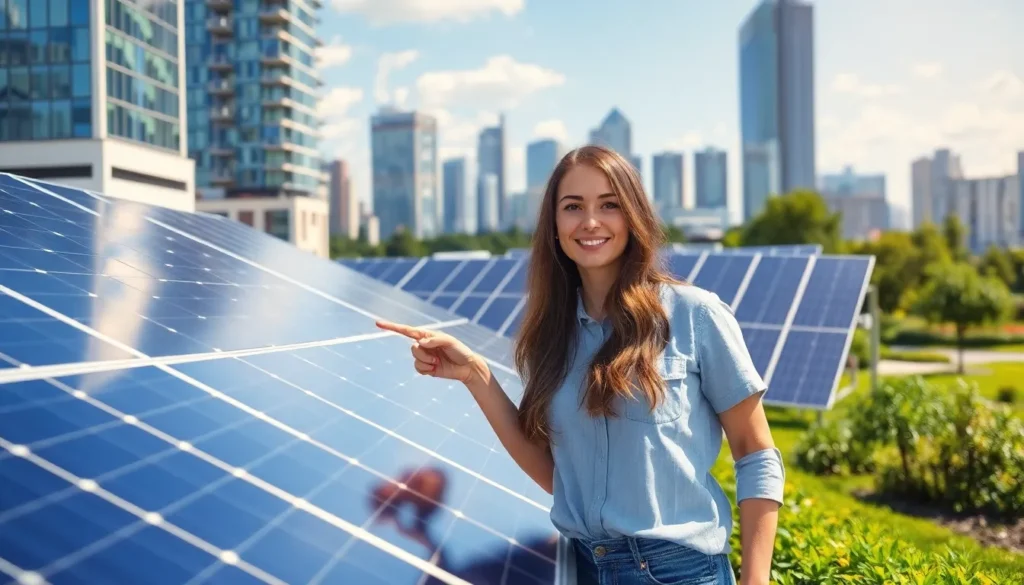Table of Contents
ToggleIn a world where the coffee’s getting cooler but the planet’s heating up, green tech innovations are the superhero we didn’t know we needed. These clever creations are not just saving the environment; they’re also making life a whole lot easier—and who doesn’t want that? From solar panels that dance in the sun to smart homes that know when to turn off the lights, the future is looking bright and green.
As eco-friendly solutions become the new norm, it’s time to embrace the tech that’s transforming our lives. These innovations aren’t just for tree-huggers anymore; they’re for everyone who enjoys clean air and a guilt-free conscience. So buckle up and get ready to explore how green tech is reshaping our world—one brilliant idea at a time.
Overview Of Green Tech Innovations
Green technology innovations encompass a variety of advancements that benefit the environment and improve daily life. Solar panels harness sunlight for energy, significantly reducing reliance on fossil fuels. Wind turbines generate electricity through wind energy, offering a clean alternative to conventional power sources.
Electric vehicles (EVs) contribute to lower greenhouse gas emissions compared to traditional gasoline cars. These vehicles rely on rechargeable batteries and are gaining popularity among environmentally conscious consumers. Sustainable agriculture techniques, such as vertical farming, maximize food production while minimizing land usage.
Smart home technologies enhance energy efficiency through automation. Devices like smart thermostats and energy-efficient appliances help users monitor and reduce their energy consumption. Battery storage systems allow homes to store excess solar energy for use during non-sunny periods, promoting energy independence.
Innovations in waste management include recycling systems that convert waste into reusable materials. Biodegradable packaging alternatives are becoming mainstream, reducing plastic pollution in landfills and oceans. Renewable energy sources, like hydroelectric power, utilize flowing water to generate electricity sustainably.
Research and development in carbon capture technologies aim to remove carbon dioxide from the atmosphere, addressing climate change effectively. Green building practices emphasize using sustainable materials and designing energy-efficient structures that minimize environmental impact.
These innovations demonstrate a significant shift towards sustainability. Adoption of green technology makes eco-friendly options accessible and applicable in everyday life. Efforts to integrate these technologies into various industries will shape a more sustainable future for all.
Key Innovations In Renewable Energy

Significant advancements in renewable energy drive the green tech revolution. These innovations enhance sustainability and reduce dependence on fossil fuels.
Solar Power Advancements
Solar panel efficiency continues to rise, with recent models converting over 22% of sunlight into electricity. Technologies like bifacial panels capture sunlight from both sides. These developments maximize energy output and enable installations in diverse environments. Solar energy storage solutions, such as lithium-ion batteries, allow users to harness power during peak demand. Innovations in solar tracking systems optimize panel positioning, increasing energy capture throughout the day. Integrating artificial intelligence further streamlines solar energy management, minimizing waste and maximizing efficacy.
Wind Energy Technologies
Wind turbines are becoming taller and more efficient, with some harnessing wind at heights of over 300 feet. Advanced designs improve aerodynamics, enhancing performance even at lower wind speeds. Innovations in offshore wind farms now enable larger turbines and longer blades, producing up to 10 megawatts of power each. Smart grid technology connects wind energy seamlessly to existing infrastructure. Energy storage systems, such as pumped hydro storage, are also evolving, effectively balancing supply and demand. Predictive analytics in wind forecasting optimize energy generation and resource allocation.
Innovations In Sustainable Transportation
Sustainable transportation innovations play a crucial role in reducing carbon footprints and enhancing urban mobility. Electric vehicles (EVs) are at the forefront, leading the transition to greener transportation.
Electric Vehicles
Electric vehicles contribute to lower emissions, gaining traction among consumers. The global EV market share increased to 14% in 2023, demonstrating significant growth. Major manufacturers are expanding their offerings, with more than 500 EV models available. Battery technology has advanced, reducing charging times to under 30 minutes for many models. These innovations enhance driving range, with several latest models exceeding 300 miles on a single charge. Government incentives further motivate adoption, encouraging more people to switch from traditional combustion engines.
Public Transit Solutions
Public transit solutions have transformed urban mobility, emphasizing eco-friendly alternatives. Electric buses and trams are becoming standard in many cities, significantly lower emissions. For instance, cities like Los Angeles and London report public transit emission reductions by up to 30% since implementing electrification. Additionally, bike-sharing programs encourage healthier, green commuting options. Integrating smart technology in public transit systems allows real-time tracking of vehicles, improving efficiency and user experience. Major cities now utilize mobile apps for seamless fare payments, enhancing convenience for riders.
Green Tech Innovations In Agriculture
Green technology is transforming agriculture, leading to more sustainable practices and increased efficiency.
Sustainable Farming Techniques
Precision agriculture exemplifies sustainable farming techniques by utilizing data analytics and technology. Farmers access real-time information about soil health and weather conditions, allowing them to make informed decisions. Crop rotation and polyculture reduce dependency on chemical fertilizers, promoting biodiversity and resilience. Integrated pest management minimizes pesticide use, focusing on natural pest predators. This combination of innovations lowers production costs and boosts long-term profitability.
Vertical Farming Trends
Vertical farming trends gain momentum as urban populations rise and arable land decreases. These innovative systems maximize space by growing crops in stacked layers, often indoors. Climate-controlled environments enhance growth while reducing water usage by up to 90%. LED lighting accelerates plant growth and reduces energy costs, making operations more efficient. This method also makes it possible to cultivate food year-round, providing fresh produce regardless of seasonal changes. Vertical farms are becoming a vital solution for urban food production, addressing food security concerns.
The Role Of Smart Technology In Sustainability
Smart technology plays a crucial role in driving sustainability across various sectors. By enhancing efficiency and promoting environmentally friendly practices, smart technology facilitates a shift toward a greener future.
Internet Of Things (IoT) Applications
IoT applications enhance energy efficiency and resource management. Smart sensors track energy consumption, enabling users to identify patterns and reduce waste. Data collected from connected devices informs decisions that lead to more sustainable habits. For example, smart thermostats optimize heating and cooling in homes, lowering energy usage. Additionally, IoT-enabled irrigation systems monitor soil moisture levels, allowing for precise watering in agriculture. These innovations contribute to reducing overall environmental impact and support sustainable living.
Energy Management Systems
Energy management systems (EMS) optimize energy consumption in buildings and organizations. Such systems provide real-time monitoring of energy usage, enabling businesses to identify inefficiencies. By analyzing data, EMS can implement strategies that reduce energy costs and carbon footprints. For instance, automated controls adjust lighting and HVAC systems based on occupancy. Additionally, integration with renewable energy sources allows for effective energy storage and consumption during peak hours. The adoption of EMS not only promotes sustainability but also enhances economic viability, showcasing smart technology’s role in achieving energy efficiency.
Green tech innovations are reshaping the landscape of sustainability and enhancing everyday life. As advancements in renewable energy, sustainable agriculture, and smart technologies continue to evolve, they’re making eco-friendly solutions more accessible than ever. The integration of electric vehicles and efficient energy management systems is not only reducing carbon footprints but also improving urban mobility and resource management.
These innovations highlight a collective movement towards a greener future. By embracing these technologies, individuals and communities can contribute to a healthier planet. The ongoing commitment to sustainability is crucial in addressing environmental challenges and ensuring a better quality of life for generations to come.







